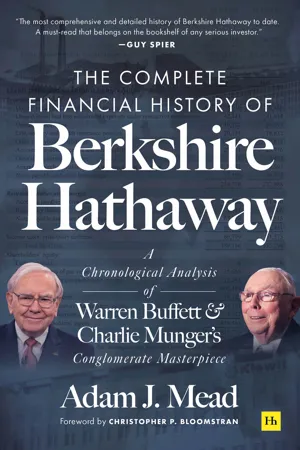
The Complete Financial History of Berkshire Hathaway
A Chronological Analysis of Warren Buffett and Charlie Munger's Conglomerate Masterpiece
- English
- ePUB (mobile friendly)
- Available on iOS & Android
The Complete Financial History of Berkshire Hathaway
A Chronological Analysis of Warren Buffett and Charlie Munger's Conglomerate Masterpiece
About this book
For the first time the complete financial history of Berkshire Hathaway is available under one cover in chronological format. Beginning at the origins of the predecessor companies in the textile industry, the reader can examine the development of the modern-day conglomerate year-by-year and decade-by-decade, watching as the struggling textile company morphs into what it has become today.This comprehensive analysis distils over 10, 000 pages of research material, including Buffett's Chairman's letters, Berkshire Hathaway annual reports and SEC filings, annual meeting transcripts, subsidiary financials, and more. The analysis of each year is supplemented with Buffett's own commentary where relevant, and examines all important acquisitions, investments, and other capital allocation decisions. The appendices contain balance sheets, income statements, statements of cash flows, and key ratios dating back to the 1930s, materials brought together for the first time. The structure of the book allows the new student to follow the logic, reasoning, and capital allocation decisions made by Warren Buffett and Charlie Munger from the very beginning. Existing Berkshire shareholders and long-time observers will find new information and refreshing analysis, and a convenient reference guide to the decades of financial moves that built the modern-day respected enterprise that is Berkshire Hathaway.
Frequently asked questions
- Essential is ideal for learners and professionals who enjoy exploring a wide range of subjects. Access the Essential Library with 800,000+ trusted titles and best-sellers across business, personal growth, and the humanities. Includes unlimited reading time and Standard Read Aloud voice.
- Complete: Perfect for advanced learners and researchers needing full, unrestricted access. Unlock 1.4M+ books across hundreds of subjects, including academic and specialized titles. The Complete Plan also includes advanced features like Premium Read Aloud and Research Assistant.
Please note we cannot support devices running on iOS 13 and Android 7 or earlier. Learn more about using the app.
Information
Table of contents
- Contents
- About this ebook edition
- About the author
- Acknowledgments
- Foreword by Christopher Bloomstran
- Introduction
- Chapter 1: Textile Conglomerate
- Chapter 2: 1955–1964
- Chapter 3: 1965–1974
- Chapter 4: 1975–1984
- Chapter 5: 1985–1994
- Chapter 6: 1995–2004
- Chapter 7: 2005–2014
- Chapter 8: The First Fifty Years: 1965–2014
- Chapter 9: 2015–2019
- Chapter 10: World’s Greatest Conglomerate
- Chapter 11: Afterward—Berkshire After Buffett
- Sources
- Publishing details